|
|
Impacts of exchange
rate policies (page 401)
In what ways does a
country's exchange rate policy impact on the following:
-
Businesses
within its borders which carry out international transactions?
-
Foreign trading
partners?
-
Investors (both
foreign and domestic)?
|
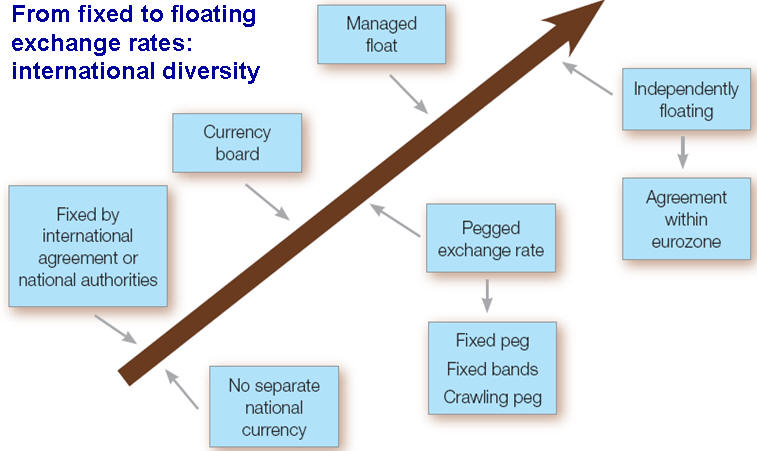
|
It is helpful first to
summarize different
exchange rate policies operated by different
governments. As
these two graphs
show, they range
from fixed to the
various types of
floating rates.
The effect of domestic interest rates and
inflation rates on spot and forward exchange rates can be
envisaged as follows. Suppose the domestic interest rates are
r¥
in Japan and r$ in the US. Also assume that the
corresponding inflation rates in Japan and the US are i¥
and i$, respectively.
|
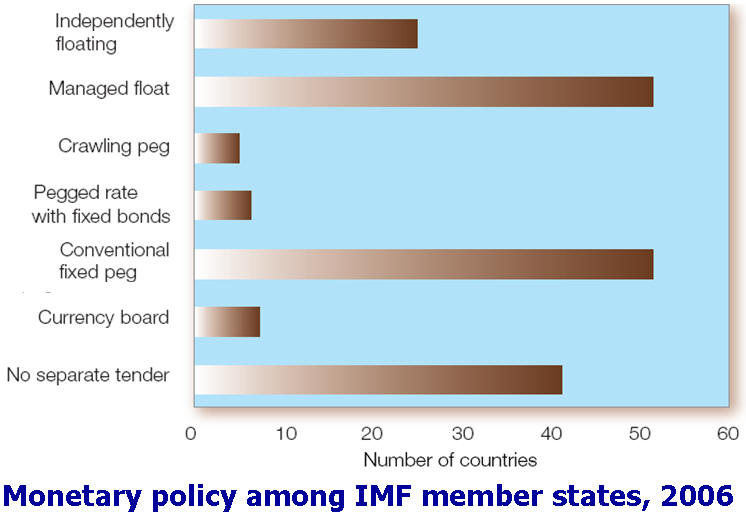 |
Now, as the primary responsibility of a country's
central bank is to guard against inflation, and setting the correct
interest rates is the basic mechanism for doing so, these two rates can
be taken to have the same effects over time. For instance, if the annual
interest rate in the US is 5% (i.e.,
r$
= 0.05) then a deposit of $100 at this rate today will become $105 after
one year. Likewise, if the Japanese annual interest rate is <2% (i.e.,
r¥
= 0.025) then
¥100
deposited today at this rate will become
¥102
after one year.
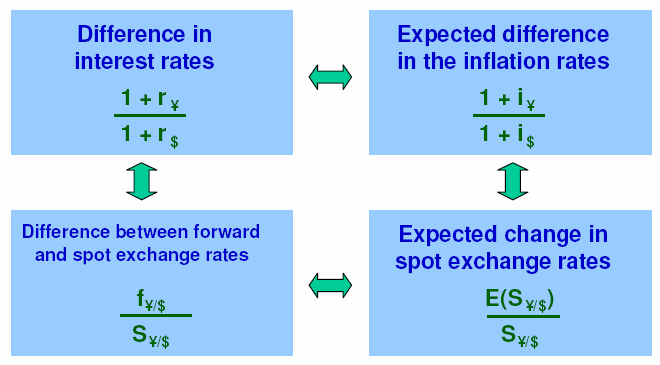
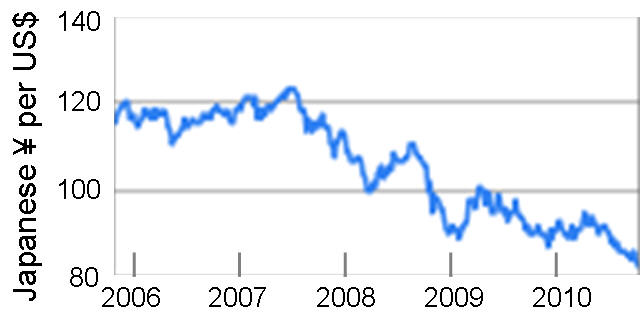
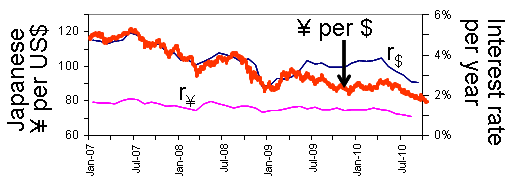
The following are the
impacts that a country’s exchange
rate policy has on
the different businesses, trading partners and the investors:
-
Businesses within its borders
which carry out international transactions
– The fixed exchange rate
offers certainty to these businesses, but it might be set at a rate
which is not particularly favorable for the individual business. It
if is set low, exporters benefit, but if it is set high in relation
to market perceptions, exporters will feel disadvantaged. A floating
exchange rate subjects it to market forces. This could seem
preferable, but much depends on market perceptions: if the currency
is strong, exporters may not be so happy.
-
Foreign trading partners
– Foreign trading
partners are sensitive to the possibility that a government may wish
to see its currency undervalued, and this may create trade tensions.
Governments can use the policy of devaluing the currency, which
helps domestic businesses, but disadvantages foreign trading
partners.
-
Investors, both foreign and
domestic –
Investors committing themselves to FDI projects wish for stability
in exchange rates, so that they can plan ahead with confidence.
However, portfolio investors may be short-term in their outlooks,
and may simply look for financial gains. The opening of capital
markets around the world has left many countries vulnerable to
speculative activity, which can affect their currencies. Those
pegged to the dollar were vulnerable in the Asian financial crisis.
Where the currency is allowed to float, volatility is especially a
risk in a small, open economy. Governments do intervene to prop up
the currency, but this is seldom effective.
|
Globalization and
stock markets (page 410)
Contrast the stock
markets described in this section in terms of their
internationalization. Assess the extent to which stock markets at
present are indicative of globalization trends or, alternately, more
local factors. Give examples.
|
Stock markets become internationalized as more
foreign companies list on them through IPOs. Investors also indicate
international appeal if they invest in stocks listed on exchanges other
than their own. The extent of internationalization of an exchange
depends heavily on the regulatory framework of the exchange. Exchanges
are all overseen by regulators associated more or less closely with
their national governments. The law in some countries does not allow
foreign investors or foreign companies to list. As shown in the figure
below, the Chinese exchanges do not allow foreign companies to list. The
most internationalized are American and European exchanges.

Japan attracts few foreign listings. The stock
market is indicative of the extent of globalization in the country’s
financial system. London as a financial centre has become highly
globalized, attracting listings from companies in large emerging
markets, such as Kazakhstan and Russia.
Some exchanges, such as the Dubai one featured in
CF 11.2, aim specifically to attract foreigners. One means has been to
set up a regulatory framework similar to that in the UK. This has not
been entirely successful: local companies, accustomed to rather opaque
governance, were reluctant to sign up to a system which did not accord
with their way of doing things, and foreign companies were perhaps
dissuaded by the local cultural and political environment (as well as
the newness of the exchange). Thus, both local and global factors play a
part. Some of the exchanges in emerging markets, such as India, China
and Russia, have been very volatile. They have risen dramatically, only
to fall equally dramatically, suggesting that they have not yet reached
the maturity which would assure foreign investors.
|
Corporate finance alternatives
(page 415)
Assess the available means of
raising capital, together with their benefits and drawbacks, for the
following companies:
|
|
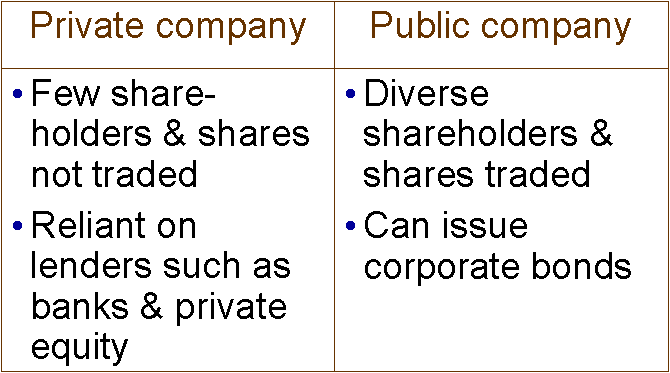
|
Debt and equity
financing
Corporate preferences for
debt or equity financing are linked to ownership and governance
structures in national environments. In economies with open
markets for shareholder participation and control, equities are
a favored way of raising capital, whereas in more closed, more
narrowly controlled market, debt financing is preferred, usually
through banks. Private companies, especially SMEs, have fewer
capital-raising options than public companies; their shares are
not traded, and debt financing is more limited. |
This company has limited
means of raising money. It is funded by the insiders who are its
shareholders. It can seek bank loans, but these are sometimes
difficult to obtain, especially during a credit crunch. Raising
finance could therefore be difficult. This type of company often
seeks help from venture capitalists who recognize the potential in
the business.
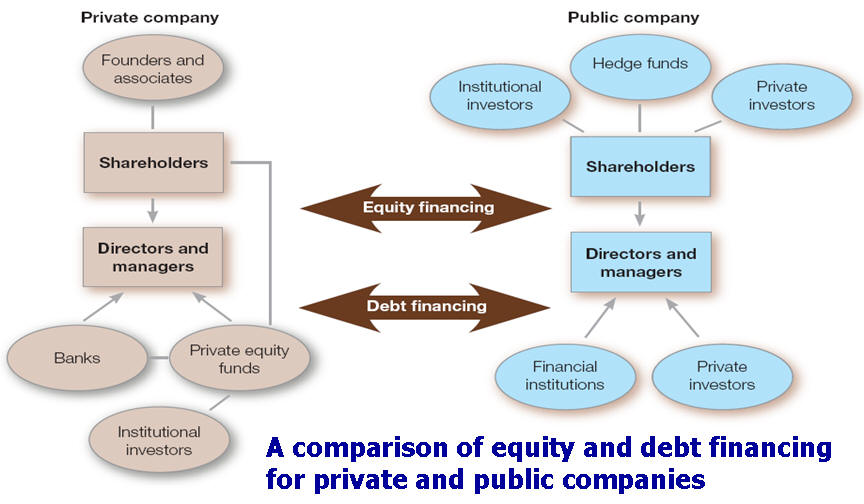
-
The large public company with
subsidiaries in many countries
–
This company probably has numerous shareholders. At least a portion
of its shares are freely traded. It could be the major shareholder
in its subsidiary companies, which are registered in the countries
where they are located. The parent company can raise capital by
equity issuance, and by loan capital (the issuing of debentures).
|
Winners and losers in
battles for corporate control (page 418)
Takeover situations
can be viewed from a number of different perspectives. What issues
are raised for each of the following groups, and how likely is each
to gain from a takeover?
-
Shareholders of
the acquiring/acquired company.
-
Managers of the
acquiring/acquired company.
-
Employees of
the acquiring/acquired company.
|
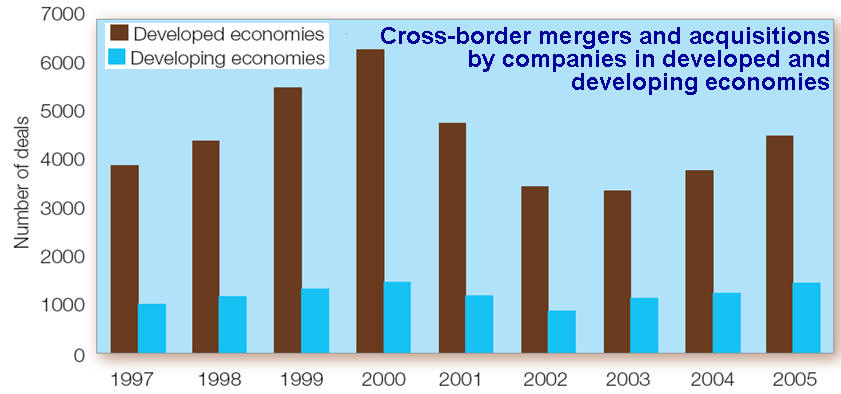
Winners and losers in takeover situations:
Shareholders
– Shareholders are concerned
about the value of their shares, their voting power, and their voice in
the company. Shareholders of the acquiring company can expect to see
their shares fall in value as a rule, and shareholders of the company
being acquired see theirs rise. The reasons for the fall in the
acquirer’s shares are that the shares will be diluted with the influx of
new shareholders, and the risks involved could well impair performance,
at least in the short term.
Managers
– Managers are concerned about
changes of strategy and structure, which are often entailed in a
takeover. Those in the acquiring company may see opportunities for
themselves, but this would mainly be in takeovers where the new business
is in the same sector as the acquirer’s business. Managers in the
acquired company are likely to be fearful of losing their jobs – only
the best might be kept on. They might also be concerned about the change
of direction. Many managers in takeover target companies will leave,
unhappy about the uncertainties or simply because they do not want to
work for a company which is owned by another.
Employees
– Employees are concerned about
their jobs, any new roles, and place of work. Those in the acquiring
company are generally thought to be safer in their jobs than those in
the acquired company. Employees in the acquired company might be offered
a new job in a new location, but might not be happy with the upheaval.
Employees in the company taken over are usually vulnerable in this
situation. Their employment rights are protected in the EU by the
Transfer of Undertakings Regulations.
|
The good, the bad and
the risky (Page 423)
Hedge fund and
private equity fund managers argue that their active investment
strategies stir up complacent incumbent managers, acting as catalyst
to achieve better performance and long-term value creation. If this
represents the 'good', what are the 'bad' and 'risky' aspects of
their activities?
|
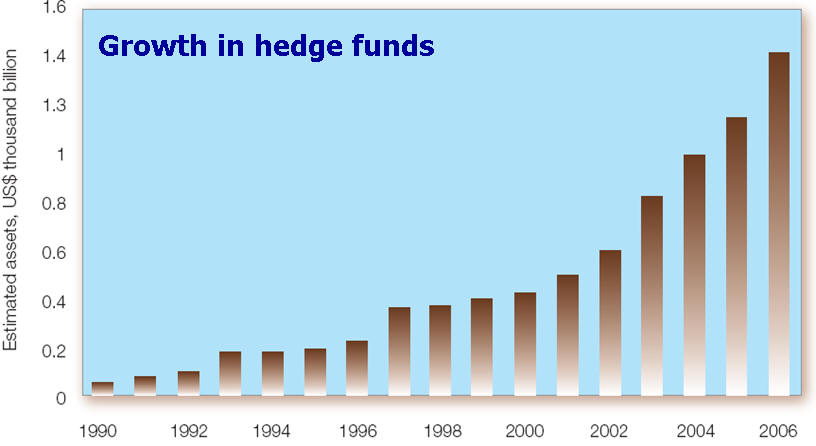
Aspects that might be considered ‘bad’
-
Hedge funds and private equity groups tend to
have short-term perspectives. They are mainly interested in gains
for their investors, rather than the interests of target companies.
-
The tactics of hedge funds are sometimes
considered dubious. They deal in derivatives such as share options,
and can build up positions without the company’s knowledge. They
also have a poor reputation for going ‘short’ on shares, in the hope
they will fall in value.
-
Private equity groups typically use debt
financing to finance their buyout activities, building up the debt
burden on target companies.. This creates a huge burden, as the
Debenhams example shows.
-
Restructuring often entails job losses in the
target company. This could be seen as good, but not from the point
of view of the person who has lost a job. By contrast, the private
equity buyout partners reap huge rewards from their activities, many
of which have successfully exploited tax loopholes.
Aspects that might be considered ‘risky’
-
Hedge funds and private equity groups have
relied on the availability of loans at advantageous rates. Any rise
in interest rates or reduced availability of loans (the credit
crunch) dramatically affects their business model.
-
Weak accountability and lack of regulation
creates risks in the operations of hedge funds and private equity
groups. Financial crisis in late 2008 seriously affected both.
Existing investors wanted their money back, and new investors were
in short supply.
|
IFRS and beyond
(page 430)
What trends are evident in the
changing regulatory environment, which impact on MNEs? To what
extent are these changes constraints on their activities or
beneficial in their value-creating activities?
|
|
IFRS rules are designed to harmonize accounting
standards, and also to make firms present a more accurate and
informative picture. For companies which have in the past used practices
which give a rosier picture than would be presented under the new rules,
the new standards represent a constraint.
An example is the treatment of
financial instruments, including derivatives. These must be measured at
fair value and included in the profit and loss account. The treatment of
leases, which involve long-term debt, must now reflect this reality,
rather than be treated simply as assets. |
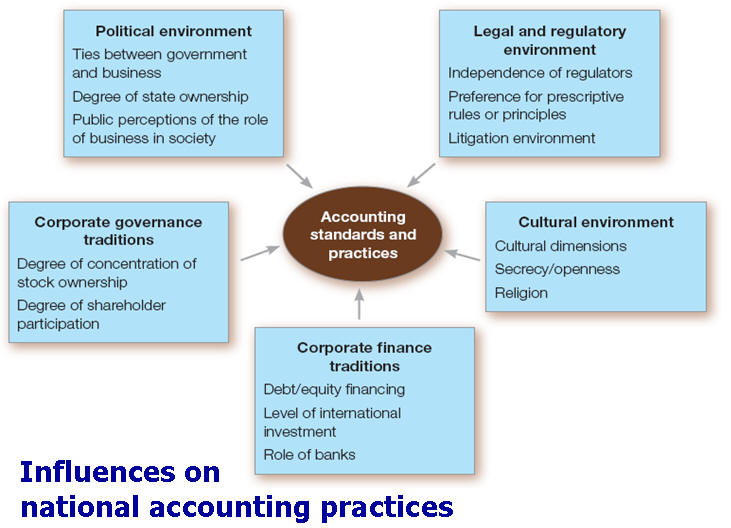 |
Likewise, the cost of
employees’ benefits, including share options, must be disclosed, and
treated as operating expenses.
Following the collapse of Enron, the US
legislature passed the Sarbanes-Oxley Act. One of the concerns which
arose in the Enron case was the extent of special purpose entities,
which were kept off-balance sheet. The new law did not ban their use,
but revised the rules for disclosing off-balance sheet debt. Much of the
new law concerns compliance requirements for certifying accounts. CEOs
and chief financial officers became liable for certifying the company’s
accounts. Criminal penalties for reckless certification were increased.
The impacts on MNEs included increased costs of compliance with
Sarbanes-Oxley rules, which also applied to foreign companies listed in
the US. The US trend was to increase legal formalities, but many might
question whether this is effective: some companies will simply find ways
of getting round the law.
|
This is a broad question., which could constitute a written
assignment. The student could begin by summarizing the differences between
regulatory environments in contrasting countries. These would include an
advanced economy, an emerging economy and a developing economy. The advanced
economy will have a sounder, independent institutional environment.
Regulation in financial systems aims to assure those who carry out
transactions, and the investing public generally, that the system is fair
and transparent. If there is a financial scandal involving fraud and false
accounting, people blame not just the parties, but the regulators, for
failing to catch what was going on. Note that the Sarbanes-Oxley Act
introduced heavier criminal penalties. However, scandals can occur in any
country, shaking confidence in regulators.
If the cultural environment is one in which the rule of law
is widely respected, regulation is more effective than in an environment in
which players are constantly striving to get round the regulatory
requirements. A portion of players in any market will be in the latter
category. The section on this subject in the chapter highlights the weakness
of the legalistic approach to regulation, and suggests that a CSR approach,
which touches on values as well as forms, might help in the reform of the
regulatory environment.
A concern in emerging and developing economies is that
notions of independent regulators, not influenced by political and personal
ties, are not well established. Here, there is more scope for corruption,
even though the regulatory bodies and enforcement methods look, on the
surface, similar to those in countries with more robust institutions. The
strategic crossroads box on Indonesia highlighted that investors had been
welcome, but many suffered losses in the financial crisis, mainly due to the
weak financial and legal frameworks. Investing in Russia would entail
similar risks, with the addition of political intervention.
Hong Kong’s competitive advantages are at risk of erosion if
the mainland authorities decide to impose stricter controls in Hong Kong.
Hong Kong’s stock exchange is becoming more integrated with the mainland
economy as so many mainland companies are listing there (including
state-owned ones). Possibly paradoxically, if the mainland regime becomes
more open and transparent, Hong Kong’s competitive advantages could be
eroded.
As a SAR (special administrative region), Hong Kong was
assured some autonomy at the time of handover by the British to China in
1997. However, there is only limited democratic participation in the
election of the Legislative Council, and Beijing is essentially in control
of the process. There has been an active prodemocracy movement in Hong Kong.
The question touched on in the case study is whether Hong Kong needs
democracy to protect the rule of law. Most students would probably say that
it does, and that control from Beijing jeopardizes the rule of law. The rule
of law has been a key element in Hong Kong’s open economy. Tightening
control by Beijing would probably weaken the attractiveness of the SAR for
international investors.













